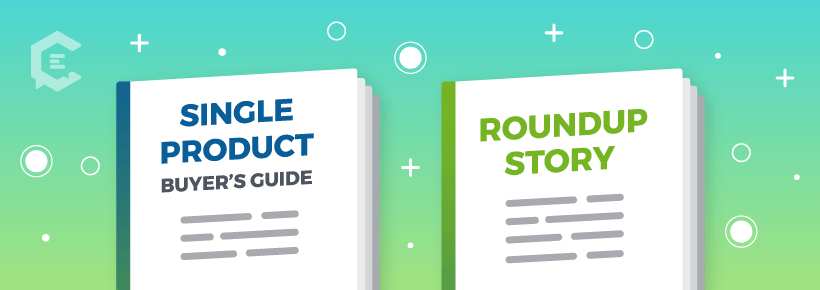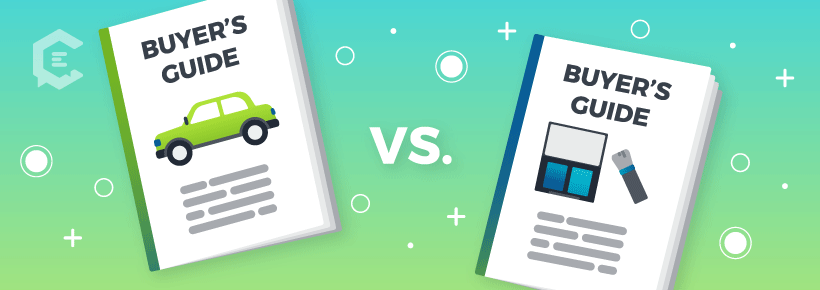How do you make a buyer’s guide to strengthen your brand? We’ll provide you with tried-and-true tips and go into detail over a series of five posts. For part one, let’s start with the why and general approaches you should consider first.
Buyer’s guides are core content types for many marketers for a good reason; when done right, buyer’s guides provide uniformity, reliability and transparency. Buyer’s guides also consistently allow marketers to engage directly with consumers without having their message diluted or product reputation muted.
After all, if you’re selling something or want to interest people in your company, products, or even services, shouldn’t you fully explain to people what sets you apart?
And while you’re at it, comparing your product and brand to competitors doesn’t necessarily weaken your brand. It might just strengthen it.
Do you need a buyer’s guide?
A well-crafted buyer’s guide or even an ebook on a very specific topic allows a brand to own their products, backstory and brand hallmarks while sharing them with desired and existing customers or end-users. Even if you’ve never written one before, it’s never too late to create one for your brand or product.
With consumers being pummeled with endless and sometimes dubious reviews on even reputable sites like Amazon, they need additional sources of reliable information.
There’s also the concept of review coercion, where a business might try to encourage customers to post positive reviews. Back in 2012, Mashable ran a story about Yelp where they discussed the brand’s approach to reviews in general. “The company believes in quality over quantity,” was the overall ethos. And that approach to positive buzz around a brand holds true.
Think of it as a relationship guide
If you create a quality guide for people to refer back to and share, you’re also creating a relationship with someone before they buy. And don’t limit your guide to simply extolling the virtues of your particular brand, try to be inclusive about the history of your product and the ways you became an industry leader.
While consumers can be fickle, speaking to their concerns or answering their questions before they add something to their shopping cart can make all the difference in creating a second or third sale as well.
In essence, with a global market simultaneously shrinking while become more crowded, having your own buyer’s guides means that the customer keeps coming back to you. Or at least that’s the plan!
Below, we’ll teach you how to write an effective buyer’s guide, and how to update the one you’ve already got or repurpose any sales documentation that’s been gathering dust.
The two main types of buyer’s guides
For the purposes of this series, let’s identify the two main types of buyer’s guides:
1. The single product buyer’s guide
This might be an extensive guide to buying anything from a washing machine to a used car. It might include details about previous models or the amount of wear and tear the item experienced or might in the future.
These are usually available to consumers at no cost either on a company website or even sent via snail mail. In the case of a used car, the Federal Trade Commission (FTC) even requires specific guides be created for each used car. The FTC’s Used Car Rule says that dealers have to display a Buyer’s Guide in every used car they have for sale, and give it to buyers after the sale. They also offer basic information on what to know before you buy.
2. The buyer’s guide under the guise of a roundup story
Full disclosure, I write a lot of roundups, product comparisons and gift guides, which based on feedback from readers, allows them to purchase from a place of trust. Because my readers already know and trust me, they rely on me to provide accurate and helpful information. And because I know that people rely on my opinion, I try to always be honest and helpful.
Tips for creating (or updating) a buyer’s guide
If you’re new to writing buyer’s guides, you might start off by reading up on roundups, similar to what a trusted consumer resource like Consumer Reports or Good Housekeeping might create. When you read a non-biased, product-tested recommendation, you can better get an idea of the product hallmarks that are tested, challenged or highlighted.
If you feel like you need an even greater source of inspiration, Consumer Reports puts out a yearly guide digest that includes hundreds of products from coffee makers to pillows along with a grading system. So now that you know you need a buyer’s guide, where should you begin?
1. SEO is your friend.
On the consumer information website RaveReviews, you might find roundups and recommendations on everything from the best Japanese whiskey to the best crib mattresses.
William Kennedy, marketing and creative manager at RaveReviews, explained that the process starts with a deep dive into search engine optimization:
Before selecting a product for a buyer’s guide or product ranking, we use SEO data to select products that consumers are searching for, as well as what kind of information consumers are seeking about the product. This data forms the basis of all future research as well as providing a picture of what a possible audience might be for the product review.
Let’s back up for a moment. Even if you’re writing a single product guide, you should probably do some internal analysis to help you discover the keywords consumers are using when searching for you… or your competition.
2. Create a consistent structure.
When people read your guide and then buy your product or sign up for your services, they’re making a commitment based on your promises. And if they’re repeat customers or if you offer a suite of products, you want to make the process of research as effortless for the end-user as possible.
For Kennedy, this means creating an introduction before getting to the nitty-gritty of testing a product and comparing the performance to the consumer’s claims. “The structure of our product reviews or rankings is roughly an introduction.”
Questions answered in the introduction might be:
- What is the product?
- How is used?
- What should consumers look for when shopping for the product?
Kennedy said that might be followed by “modules for each product or brand reviewed (the number of which can vary); some FAQs about the product or associated with the product (gathered from SEO data); and a few add-on products consumers searching for the primary product might also be interested in, with a brief overview of each.”
As for more strictly product testing guides, Kennedy said that might be “a combination of testing the product, manufacturing specifications, and consumer reviews. We always include a methodology section in which we outline what we looked for and what we reviewed in each product or brand.”
3. Balance the bad with the good.
Whether you’re creating a single buyer’s guide or a more rogues roundup, honesty is always the best policy. Maybe your product is cheaper than others and might have a flimsier shell. Or maybe your product is so exclusive that even the 1 percent have to talk to their accountant before shopping.
Whatever it is, make sure to explain it to your consumer. As Kennedy puts it when writing your guide, “Remember it’s not ad copy, but balance the good with the bad, and don’t rely too much on Amazon reviews.”
4. Share the love.
Let’s go back to an idea I posed earlier — including other brands with your own. This is a great idea for some companies since you can create elevation by association by positioning your brand near competitors. You can also include your own brand with the trendiest and of the moment companies.
Freelance writer Jill Schildhouse writes a lot of gift guides and roundups and has some tips for how to create a fair and balanced guide that includes both your and your competitors’ products:
I don’t feel comfortable making blind suggestions when it comes to how readers spend their money. If I receive a product I don’t like (doesn’t perform as advertised, for instance), I simply won’t include it in my guide. I try to cover products across all budgets and not stay loyal to any one brand, so that I spread the love to those who deserve it … from small companies without a marketing/PR budget to brands that are household names. I make an effort to cover products that haven’t been covered 100x in other publications, but sometimes those products are superior and fit the bill.
Much as it might hurt to support your competitor, you should probably buy and then test their product. If only to reassure yourself just how superior your own widget is.
5. Compare and contrast makes for great research.
If you’re trying to add a different voice or structure for your own guides, you can also start studying guides from industries that don’t relate to your own. For instance, the mattress business has become incredibly crowded over the past few years.
Spending time studying the way each brand not only highlights their unique selling points along with the way they describe the most basic things like mattress firmness can provide inspiration.
“I almost always gather more products or brands than will be included in the buyer’s guide before winnowing them down to the products that will be included in the ranking,” Kennedy said. Only after he’s done that does he, “write copy for each before actually ranking the brands. Where each product lands in the ranking can change after taking that kind of deep dive into the relative merits of each.”
Some additional tips to keep in mind when crafting your buyer’s guide:
Balance is everything: Kennedy said, “I’m suspicious of any consumer review that’s too positive or overly negative.”
Remember your target audience: “Don’t rely too much on data,” Kennedy advises, and while you’re at it “always have an audience in mind, even if it’s yourself. How would you actually use the product?”
Read our full 5-part series on how to create a buyer’s guide:
- How to Make a Buyer’s Guide for Your Brand
- Why Understanding Your Audience Is Key to a Great Buyer’s Guide
- Jargon vs. Keywords: How to Know What Sells Your Product in a Buyer’s Guide
- Creating a Foundation for Your Buyer’s Guide
- 7 Expert Tips to Help You Avoid Common Buyer’s Guide Mistakes
Or take your content creation a step further
Did this article help? Managing content creation and production comes with a lot of challenges. But you don’t have to deal with them all yourself. Working with a trusted partner can take a lot of the guesswork and energy out of the process. Connect with one of our specialists to see how we can scale and improve your content creation to drive your brand’s success.








